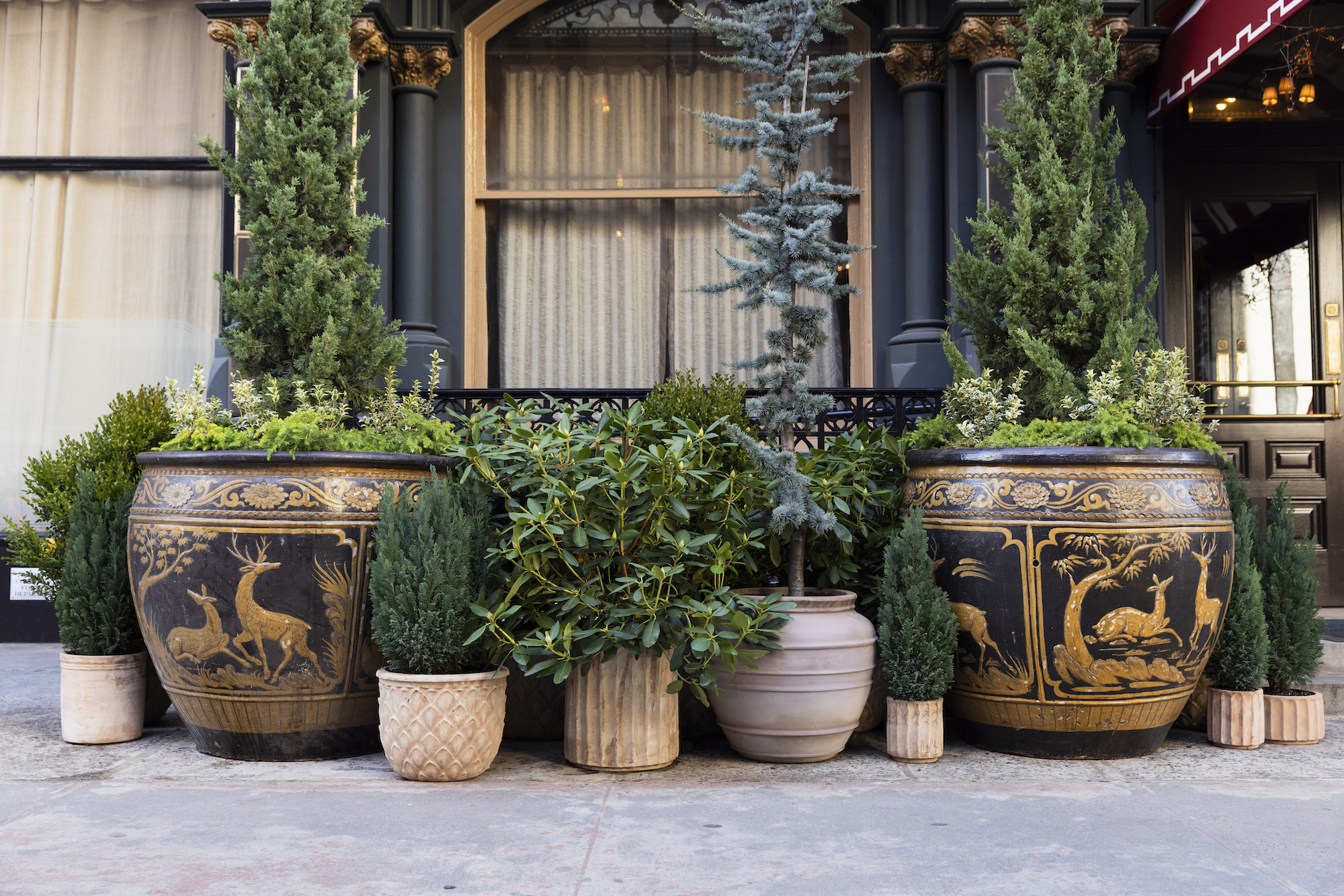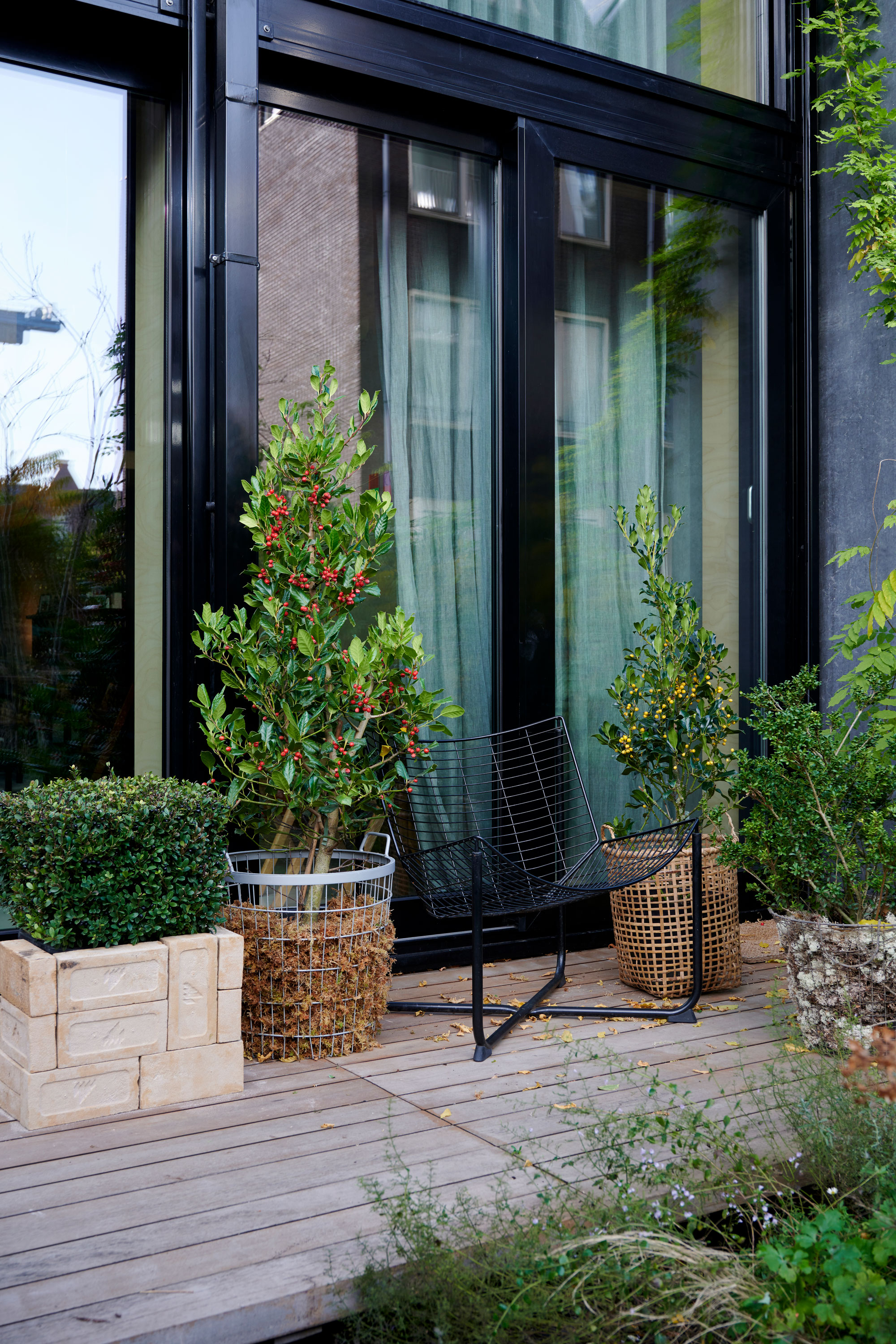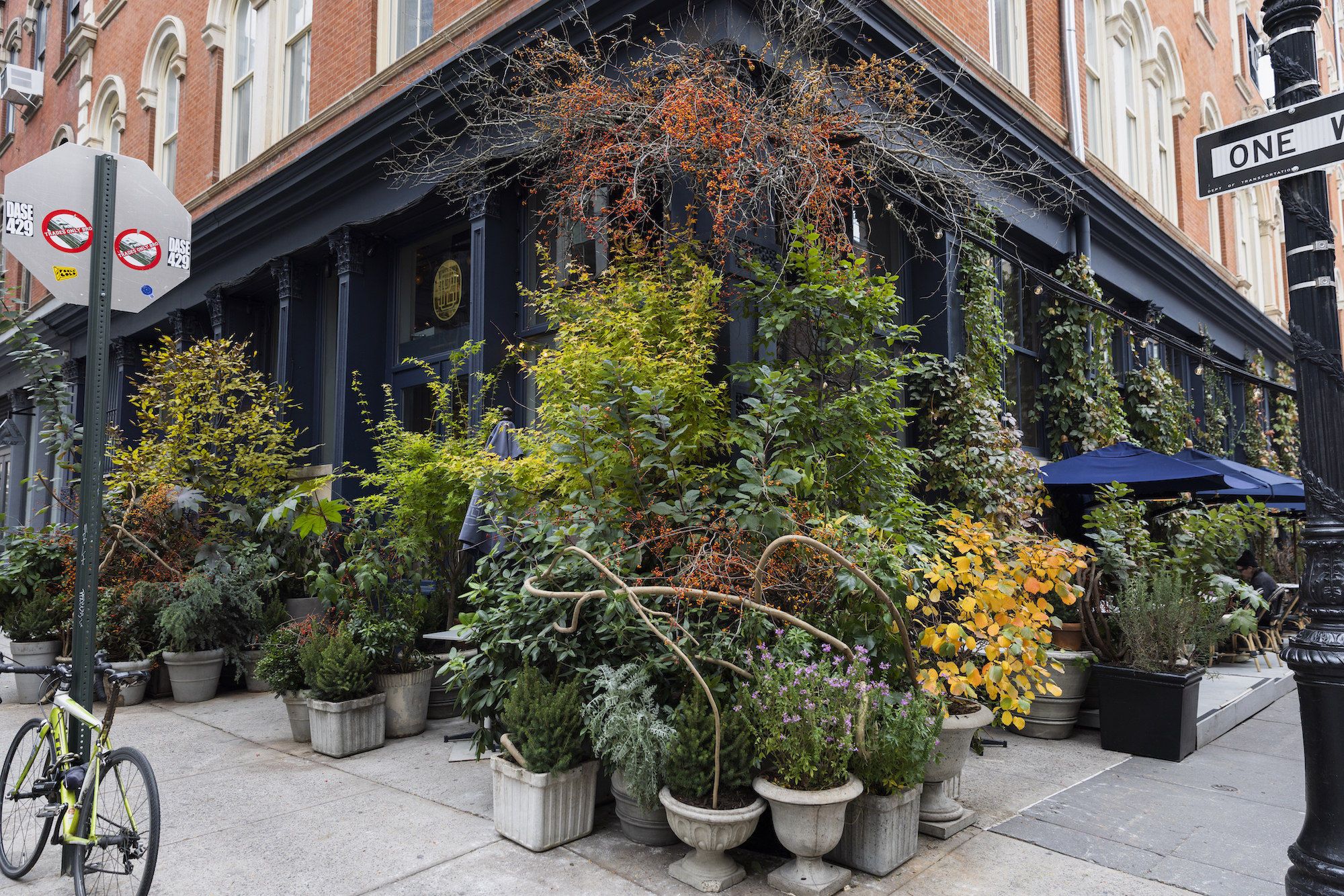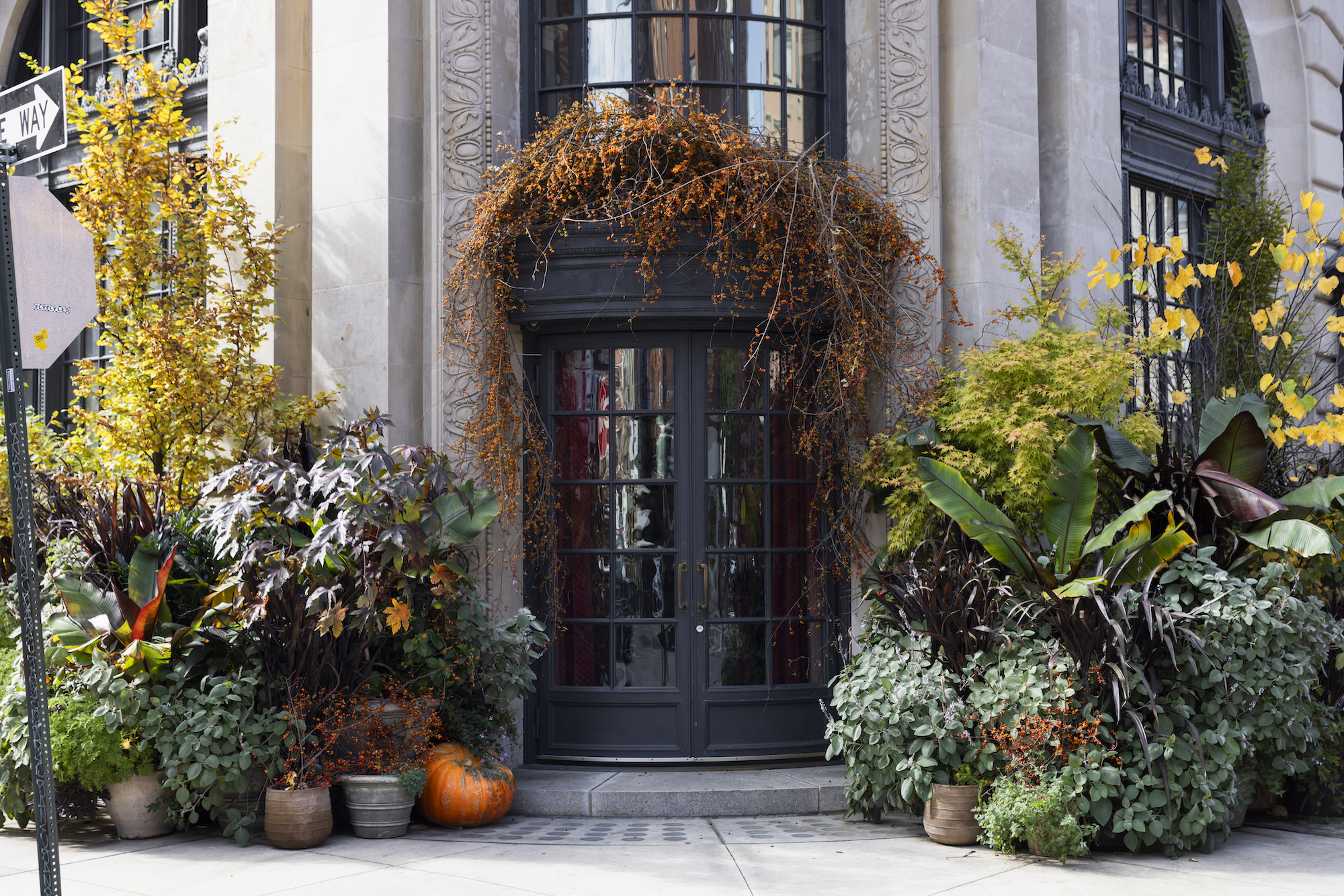
Evenings on the patio aren’t over yet. Sure the temperatures are cooler and the leaves are beginning their amber-toned transformation, but we think a patio should be enjoyed all year round. After all, what could be better than enjoying s’mores on your patio’s firepit while wrapped in a cozy throw?
But if you’re going to achieve the perfect atmosphere for your patio, you’re going to want to freshen up your containers. Come fall, most container annuals are past their best, and potted perennials have gone to seed or started to die back. But just because the season of big summer blooms has passed, doesn’t mean you can’t enjoy colorful patio containers this fall.
The trick? Picking the perfect plants. And who better to fill you in on the dos and don’ts of fall gardening ideas for your patio than an award-winning landscaper, renowned for their iconic urban balcony designs?
1. Switch summer annuals for fall plants

Summer annuals, especially, are known for taking on a tatty appearance when the cooler months hit. So switching these spent flowers up for foliage that will still look great come winter is a must if you’re going to keep your patio looking good.
According to urban landscape designer Thomas Little, at Urbangreen, when it comes to what to grow in planters in the fall, rich green shrubs are a great place to start.
"Fall is a transitional season, the challenge of plant selection for containerized plantings is to find offerings that can endure the shift from the warmer, drier months of September and early October and the cooler beginnings of November and early December," says expert Thomas.
"For this we recommend a mix of conifers such as Hollywood juniper, Arizona cypress, and woody shrubs such as Rhododendron roses elegans and Delaware white azalea,’ says garden expert Thomas. ‘If your space is extremely limited, perhaps consider evergreen perennials that retain a presence and bring interest well into winter, such as Hellebores, Coral bell, and all varieties of Miscanthus."
If you want our opinion, you can’t beat hellebores for container gardening in the winter. Available in a huge variety of shades and patterns, not only are they incredibly detailed but they also have evergreen foliage that looks great throughout all seasons – an ideal fit for all patio gardens! For inspiration, look out for varieties like Helleborus “Diamonfire”, this plant features delicate green and pink ombré petals. Or, for something more Christmassy and rich to contrast against its deep green foliage, look out for Helleborus “Double Black”.
2. Embrace the bare

Fall is a transitional season, nature is moving on and preserving itself for the colder months. So while you might want to rush to replant every container with fresh foliage, combining old with the new can be a great design technique at this time of year too.
Not every plant will make the cut, of course, but some shrubs and flower seedheads can bring architectural detail to a garden space. Spent alliums, and echinacea flowers that have gone to seed look beautiful when left in flower beds and containers. Plus, the seedheads are essential for helping out wildlife when food sources are low in winter.
Bare branches from deciduous shrubs like fruit trees and dogwood act as a framework for your other plants to complement. After all, variety is everything in gardens – especially when it comes to texture. Contrasting a long wispy grass such as miscanthus against the more robust evergreen leaves of a rhododendron will only emphasise each other's aesthetic features. So don't be in a rush to replace everything, take your time to consider your design and edit accordingly.
3. Plant up Evergreens

While plant swapping throughout the seasons is a good method of livening up containers without commitment, sometimes a lower-maintenance plan for our patios is required – especially in fall when gathering leaves seems all-consuming. We’re talking about designs that will look effortlessly good year-round, and that means evergreens!
But while an evergreen patio plant design may seem straightforward, as expert Thomas highlights, it’s important to pay attention to the basics when picking your plants — the best evergreen trees and shrubs depend on the conditions of your container garden.
"One must always take into consideration the light exposure of the patio garden. For a shady winter patio, we recommend Osmanthus, skip Laurel skimmia japonica, the very striking black Ophiopagon and a trailing presence of English ivy," says expert Thomas. "For the sunny containerized garden, consider the feathery softness of Cupressus leylandii, Rhododendron catawbienses, Camillia sinensis, and the evergreen perennial Euphorbia ascot."
As well as providing beautiful greenery year-round, Thomas’s top pick Osmanthus is fantastic for gardeners who enjoy spring blossoms. Varieties like Osmanthus “burkwoodii” will emerge smothered in delicate white jasmine-like flowers in the spring. Plus, with its wind-withstanding properties, Osmanthus is ideal for balconies as well as patios. Just remember to stake your less mature plants to give them the best chance of success.
4. Keep watering and feeding your containers
It’s a question asked by many – how much should you water container plants in fall? The answer, as Thomas explains, might surprise you!
"With global warming, and ideas of zonal hardiness shifting, it's now more important than ever to keep containerized plantings well watered as long as possible right up until the first frost, or the soil in them becomes frozen," says expert Thomas. "In the current climate situation, our winters are not cool enough for deep hibernation and with less snowfall, our winters have become drier too."
But container plant care doesn’t stop with watering. Feeding your containers in fall is essential, too. As gardening pro Thomas explains "Plants in containers can only hydrate and access nutrients offered to them by us, so keep them well hydrated as long as possible, late into fall and early into winter. You'll want to start watering them as early as you can — we aim for the first of March."
For a great all-round plant feed, we love liquid seaweed (try this one from Amazon). Simply dilute it in a watering can according to the instructions and incorporate it as part of your watering schedule.
5. Start growing your own Holiday gifts

Fall is the perfect time to start growing your own container plants as holiday gifts or decor! Homegrown gifts like small bowls of delicate daffodils or hyacinths are a beautiful way of celebrating the holidays with friends and family. But if you want them to be in top form for the holidays, that means getting a head start now!
Thomas explains "My favorite living holiday gifts that can be started in pots now are narcissus “Paperwhite Ziva”, all manner of Amaryllis. One of my favorites if you have a sunny spot would be the Christmas cactus. This tough little plant requires little love or attention and rewards annually with brightly colored blooms. A plant not just for this holiday season, but for many more to come!"
To start your holiday gifts like a pro, get a small container with a drainage hole (a wide and slightly shallower dish is ideal) and fill with multi-purpose compost, being sure to leave an inch free around the top. Make indents in the soil with your finger and poke the bulbs in so the sprouted head is just peaking out from the top, leaving a few inches between each bulb. Cover with a thin layer of mulch, or horticultural grit, and leave in a sunny position to grow – a windowsill is ideal. Place the pot on a saucer, and water enough to keep the soil moist but not wet and you’ll have a spectacular display ready for the holidays!







